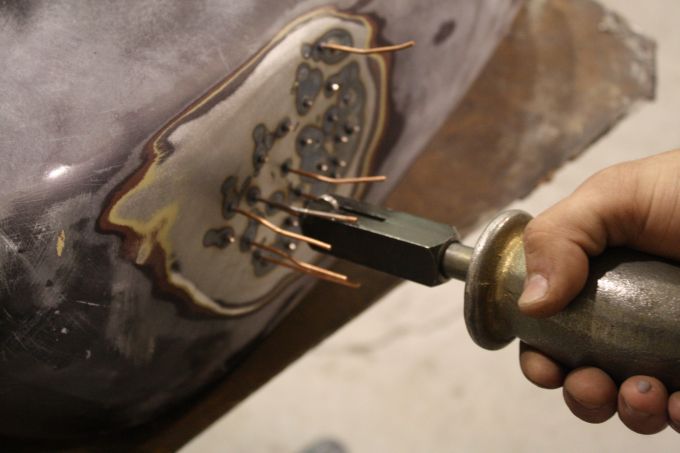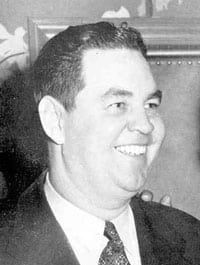
If you have a dent in your classic car or truck there are a few steps you will need to go through in order to make your door or body panel look like new again. Not only will you initially have to fix the dent itself, but will also need to then fill in any imperfections and then of course repaint the repaired area.
In this article we are only discussing some of the ways that simple dents can be repaired by a classic car owner at home. Some of the methods we are covering require the use specialized tools like a stud welder repair kit or hammer and dolly tools which most of us don’t have laying around. There are still a few other methods we cover that only require more common garage tools and household items.
Before getting into dent repair an honest evaluation of the damage needs to be made. If you wrapped your muscle car around a tree or have other serious damage to your body, you may need to replace the damaged body parts all together and pray that you do not have frame damage. The dent repair methods we are discussing are meant for minor to medium sized dents that don’t have too much creased metal.
The first method is the hammer and dolly method and is pretty much the easiest repair technique for dents, but it does require that you have access to both sides of the panel being repaired. However, some classic cars have areas that don’t provide proper access to use this method. Everyone knows what a hammer is, but these types of hammers are a special type that have different weights and differently shaped heads depending that are specific to the surface you are working. Dollies on the other hand are just heavy, simply shaped pieces of steel that fit into the palm of the your hand.
You place the dolly on the back side of the dent in the metal and then carefully begin to tap on the metal from the other side. You’re basically using the steel dolly as a backing to absorb the blows. By no means do you need to slam the hammer hard as you work the metal back into shape. It takes practice to be able to get the metal back to its original state, but can produce amazing results! When you start use only the hammer at the edge of the dent and work your way inward until it gets close to it original shape. Then use the dollies to help in the final stages of metal straightening to level the smaller imperfections. Be careful not to use the dollies too much as it can stretch the steel making it too thin.
The next method is commonly used in auto body shops. It does require the use of a stud welder which most homes don’t have, but if you do or can get your hands on one it makes repairing dents easy when you don’t have access to the backside of the panel to use the hammer and dolly method.
The first step is to grind off all the paint around the source of the dent. You will need a bare metal surface in order to weld a stud to the metal.
Once the metal is all prepared you can load a stud into the stud welder and then carefully place the stud welder against the area you wish to attach the stud. Again you will want to start at the outer most part of the dent and gradually working your way inward. There is a copper ring on the stud welder that acts as a ground when it comes in contact with the bare metal allowing electrical current making the weld possible. Once you are sure that the welder is placed properly pull the trigger to initiate the weld, but do not pull the trigger for more than 3 -4 seconds. Pulling the trigger to long may burn a hole right through the metal.
You then clamp a dent puller to the stud and slide the weight away from the dent which then pulls the metal outward. Be careful not to pull to hard on the hammer as this can stretch out the the metal and shrinking it back into place can be very tough. Repeat attaching studs inward and pulling the metal outward until you are satisfied with the results. You can then cut off the studs and grind their bases down to the original metal.
You can still use a slide hammer to remove dents if you don’t have a stud welder. There are threaded tips for dent pullers that can attach to the end of the slide hammer. You then drill pilot holes in the dent and screw the slide hammer tip into each hole until snug. You can then use the slide hammer in the same way you would if you attached it to a stud. Once you are complete you will need to fill in the holes with body filler and sand it down to be refinished.
The remaining techniques are used on minor dents that have not caused any creases or cracked the paint. There are suction cup dent pullers available that are relatively easy to figure out and use. There are single and double suction cup varieties depending on the size of the dent. Firmly attach the suction cup directly to the center of the dent and pull. If you require more pulling strength than your arms can provide you can use the pulling strength of a ratchet strap. Attach one end to the suction cup and the other end to something very sturdy like a large tree or telephone pole. You can then use the power of the ratchet to help pull out the dent. Just be sure you attach the ratchet strap to something very sturdy to avoid causing any other damage.
If all else fails there is one last method that is somewhat of an urban legend to us, but might be worth a try. It requires using the heat from a hair dryer and the cold from either a can of compressed air or dry ice. Please be careful when using the hot then cold technique. It is advisable to have safety glasses and insulated gloves to protect yourself from frostbite or being burned.
You can see detailed instructions on this method by clicking here, but the gist of it to apply heat to the dent from the hair dryer for a few minutes to heat up the dent, but being careful not to damage the paint from the heat. Once the dent is heated up you can quickly cool it by turning the can of compressed air upside down and spraying it directly on the dent. You can also use dry ice to apply cold to the dent but it is suggested to use a sheet of aluminum between the dry ice and your car. (You will also want to make sure you are wearing the proper gloves to handle dry ice.)
The theory is that after a few minutes of applying the heat and then the cold that the metal will make the metal of the car expand and then quickly contracting which will cause the dent “pop” back to its original shape. Apparently you may need to repeat this process a few times, but we suggest that if it doesn’t work after one or two time you resort to one of the other methods described above.

